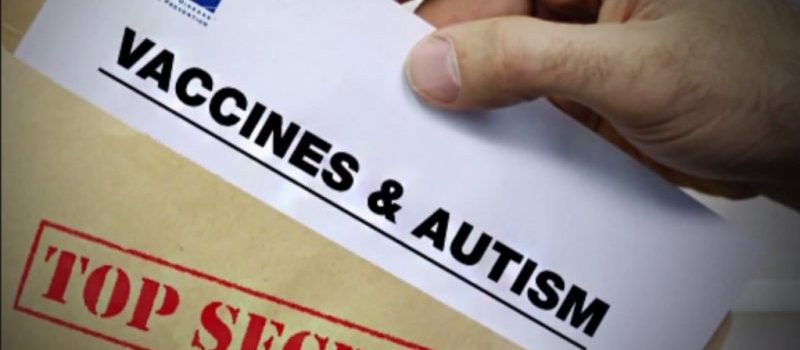Contributing writer for Wake Up World
A long-held debate between pro- and anti-vaccination groups may finally be put to rest over the association between thimerosal — a preservative composed of 49.5% ethyl mercury used in numerous child and flu vaccines — and neurological disorders, particularly autism.
For nearly a decade, biochemist Brian Hooker, Ph.d., has been petitioning documents from the Centers for Disease Control and Prevention (CDC) under the Freedom of Information Act (FOIA) in relation to the controversial preservative. After more than 100 requests, the documents were eventually released — and clearly showed thimerosal can in fact cause autism and other neurodevelopment disorders. But this isn’t the only study that demonstrates the brain and health harming nature of the compound.
Toxicity of thimerosal no longer in question
A study in the Journal of Toxicology from the Methodist Hospital Department of Neurosurgery in Houston, Texas, establishes thimerosal as a potent mitochondrial toxin in human brain cells. Researchers found thimerosal-derived ethyl mercury not only inhibited mitochondrial function, but also increased the formation of potent brain-damaging oxidants. The authors conclude: “The results of this study suggest that ethyl mercury is a mitochondrial toxin in human astrocytes [cells associated with neurons in the central nervous system]. We believe that this finding is important, particularly since the number of diseases in which mitochondrial dysfunction has been implicated are rapidly increasing.”
Additionally, Sharon E. Jacob, M.D., and Ran Huo, B.S. write:
“The main concern with thimerosal involves its metabolite — ethyl mercury. Hat makers, or “hatters” in the 1800s, were notorious for suffering from dementias due to the mercury nitrate used in felt processing. This mercury-associated dementia in felt workers was the inspiration for the Mad Hatter in Lewis Carroll’s Alice in Wonderland and the origin of the phrase “mad as a hatter”. The Mad Hatter’s disease, also known as erythrism, includes a constellation of dementia, stomatitis, muscle spasm, tremor and skin rashes. … Acute or chronic exposure to organic and inorganic mercury can result in renal, neurologic and dermal toxicity.” [source]
According to findings by Dr. Paul King, ethyl mercury (thimerosal) is metabolized by the body into methyl mercury — the most dangerous and deadly form as it’s retained in bodily tissue and poses long-term toxicity issues.
Over 75 documents and studies demonstrate the adverse effects of thimerosal, many of which are related to irregularities in autistic children. As a mercury-containing compound, thimerosal is a recognized human carcinogen, damages the immune system, can cause anaphylactic shock and is a known reproductive and fetal toxin.
Safety issues of thimerosal caught the attention of the U.S. government and, in November 1997, Congress passed the Food and Drug Administration Modernization Act, which required an investigation into the mercury content of FDA-approved products. Because of this, previously unrecognized levels of ethyl mercury in vaccines were brought to light.
In July 1999, health officials announced the compound would be phased out of vaccines. The CDC, American Academy of Pediatrics and FDA all claimed the measure was simply a precaution. Vaccine manufacturers were asked to eliminate mercury from vaccines. The request was refused year after year.
Which brings us back to Dr. Hooker’s mission to uncover the truth about thimerosal buried within the CDC.
Officials knew in 2000 that thimerosal is associated with increased risk of autism
Brian Hooker, PhD, PE, is an associate professor at Simpson University and specializes in biology and chemistry. He also has over 15 years of experience in the field of bioengineering. Throughout his career, he has published science and engineering papers extensively in peer-reviewed journals. Dr. Hooker’s son, who is now 19, was developmentally normal until after receiving thimerosal-containing vaccines as a child, where he subsequently regressed into autism. This experience began Dr. Hooker’s search for the truth behind thimerosal in vaccines and decade-long quest to review crucial data from a massive CDC study on the compound.
Once Dr. Hooker obtained the documents in question, the link between autism and thimerosal was undeniable. The data covering over 400,000 infants born between 1991 and 1997 was analyzed by CDC epidemiologist Thomas Verstraeten, MD, “proves unequivocally that in 2000, CDC officials were informed internally of the very high risk of autism, non-organic sleep disorder and speech disorder associated with thimerosal exposure.”
Furthermore, PR Web notes:
“When the results of the Verstraeten study were first reported outside the CDC in 2005, there was no evidence that anyone but Dr. Verstraeten within the CDC had known of the very high 7.6-fold elevated relative risk of autism from exposure to thimerosal during infancy. But now, clear evidence exists. A newly-acquired abstract from 1999 titled, “Increased risk of developmental neurologic impairment after high exposure to thimerosal containing vaccine in first month of life” required the approval of top CDC officials prior to its presentation at the Epidemic Intelligence Service (EIS) conference. Thimerosal, which is 50% mercury by weight, was used in most childhood vaccines and in the RhoGAM® shot for pregnant women prior to the early 2000s.”
Congressman Dave Weldon, MD, also expresses concern over the study to Julie Gerberding, Director of the CDC, in the following letter:
Dear Dr. Gerberding:
I am writing to follow up on our conversation about the article (Verstraeten et. al.,) that will be published in the November 2003 issue of Pediatrics. I have reviewed the article and have serious reservations about the four-year evolution and conclusions of this study.
Much of what I observed transpired prior to your appointment a year ago as the Director of the Centers for Disease Control and Prevention (CDC). I am very concerned about activities that have taken place in the National Immunization Program (NIP) in the development of this study, and I believe the issues raised need your personal attention.
I am a strong supporter of childhood vaccinations and know that they have saved us from considerable death and suffering. A key part of our vaccination program is to ensure that we do everything possible to ensure that these vaccines, which are mandatory, are as safe as possible. We must fully disclose adverse events. Anything less than this undermines public confidence.
I have read the upcoming Pediatrics study and several earlier versions of this study dating back to February 2000. I have read various e-mails from Dr. Verstraeten and coauthors. I have reviewed the transcripts of a discussion at Simpsonwood, GA between the author, various CDC employees, and vaccine industry representatives. I found a disturbing pattern which merits a thorough, open, timely, and independent review by researchers outside of the CDC, HHS, the vaccine industry, and others with a conflict of interest in vaccine related issues (including many in University settings who may have conflicts). [Read more]
And yet, the CDC still claims there is “no relationship between thimerosal-containing vaccines and autism rates in children,” even though the agency’s own Vaccine Safety Datalink (VSD) database shows high risk. Numerous public records also support these findings, such as this Congressional Record from 2003.
Dr. Thomas Verstraeten, the scientist who conducted the study in question, left the CDC in 2001 to work for GlaxoSmithKline (GSK), a vaccine manufacturer facing liability over thimerosal in their products.
Article sources
- “Thimerosal neurotoxicity is associated with glutathione depletion: protection with glutathione precursors,” James SJ1, Slikker W 3rd, Melnyk S, New E, Pogribna M, Jernigan S. Neurotoxicology, 2005 Jan:26(1):1-8.
- “Thimerosal-Derived Ethyl mercury Is a Mitochondrial Toxin in Human Astrocytes: Possible Role of Fenton Chemistry in the Oxidation and Breakage of mtDNA,” Martyn A. Sharpe, Andrew D. Livingston,David S. Baskin, Journal of Toxicology, Volume 2012 (2012), Article ID 373678, (http://www.hindawi.com/journals/jt/2012/373678/)
- “Increased risk of developmental neurologic impairment after high exposure to thimerosal-containing vaccine in first month of life,” Verstraeten Thomas M. MD, NIP, Division o f Epidemiology and Surveillance, Vaccine Safety and Development Branch
- http://emedicine.medscape.com/article/1175560-overview
- https://www.gpo.gov/fdsys/pkg/CREC-2003-05-21/pdf/CREC-2003-05-21-pt1-PgE1011-3.pdf [PDF]
- http://www.prweb.com/releases/ASOT/Thimerosal/prweb11598819.htm
- http://thefreethoughtproject.com/cdc-forced-release-documents-showing-knew-vaccine-preservative-autism/
- http://preventdisease.com/news/pdf/Thimerosal_Immune_System_Abnormalities.pdf [PDF]
- http://mercuryfreedrugs.org/docs/00mmdd_EISAbstractSubmission_IncreasedRiskOfDevelopmentalNeurologicImpairmentAfterHighExposureToThimerosal-containingVaccine_.pdf [PDF]
About the author:
 Carolanne Wright enthusiastically believes if we want to see change in the world, we need to be the change. As a nutritionist, natural foods chef and wellness coach, Carolanne has encouraged others to embrace a healthy lifestyle of organic living, gratefulness and joyful orientation for over 13 years.
Carolanne Wright enthusiastically believes if we want to see change in the world, we need to be the change. As a nutritionist, natural foods chef and wellness coach, Carolanne has encouraged others to embrace a healthy lifestyle of organic living, gratefulness and joyful orientation for over 13 years.
Through her website Thrive-Living.net, she looks forward to connecting with other like-minded people from around the world who share a similar vision. You can also follow Carolanne on Facebook, Twitter and Pinterest.
Further reading from Carolanne Wright:
- The Most Eco-Friendly Nation on the Planet is Now Carbon Negative
- Don’t Ask, Just Plant — Taking Back Our Food Sovereignty with Guerrilla Gardening
- Plastic Waste in the Ocean Will Outnumber Fish by 2050
- Seed Bombs: A Creative (and Fun) Mission to Save the Bees and Butterflies
- Mind Control, Subliminal Messages and the Brainwashing of America
- Autistic Boy with Higher IQ Than Einstein Discovers Gift After Removal from State-Run Therapy
- Monsanto Charged with Crimes Against Nature and Humanity – Set to Stand Trial in 2016
- Dr Sebi: The Man Who Cures Aids, Cancer, Diabetes and More
- Plastic-Eating Mushroom Discovered in the Amazon Rainforest — A Solution for Our Trash Saturated World?
- Big Pharma and Organized Crime — They are More Similar Than You May Think
- Over 100 Scientific Studies Agree: Cannabis Annihilates Cancer
- Emotional Energetic Healing: The Future of Medicine is Here
- Why Every Parent Should Consider Unschooling
- The Greenhouse of the Future: Grow Your Own Food Year-Round With This Revolutionary System
- First U.S. City Produces More Electricity Than It Uses — With 100% Renewable Technology

If you've ever found value in our articles, we'd greatly appreciate your support by purchasing Mindful Meditation Techniques for Kids - A Practical Guide for Adults to Empower Kids with the Gift of Inner Peace and Resilience for Life.
In the spirit of mindfulness, we encourage you to choose the paperback version. Delve into its pages away from screen glare and notifications, allowing yourself to fully immerse in the transformative practices within. The physical book enriches the learning process and serves as a tangible commitment to mindfulness, easily shared among family and friends.
Over the past few years, Wake Up World has faced significant online censorship, impacting our financial ability to stay online. Instead of soliciting donations, we're exploring win-win solutions with our readers to remain financially viable. Moving into book publishing, we hope to secure ongoing funds to continue our mission. With over 8,500 articles published in the past 13 years, we are committed to keeping our content free and accessible to everyone, without resorting to a paywall.








